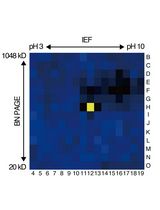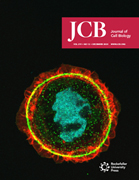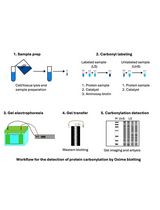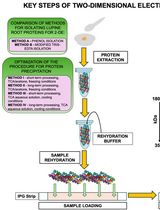- EN - English
- CN - 中文
CENP-C Phosphorylation by CDK1 in vitro
CDK1体外磷酸化CENP-C的研究
发布: 2021年01月05日第11卷第1期 DOI: 10.21769/BioProtoc.3879 浏览次数: 4957
评审: Chiara AmbrogioKuldeep Singh AttriTianjiao HuangAnonymous reviewer(s)

相关实验方案

基于活性蛋白质组学和二维聚丙烯酰胺凝胶电泳(2D-PAGE)鉴定拟南芥细胞间隙液中的靶蛋白酶
Sayaka Matsui and Yoshikatsu Matsubayashi
2025年03月05日 1874 阅读
Abstract
Accurate chromosome segregation during mitosis requires the kinetochore, a large protein complex, which makes a linkage between chromosomes and spindle microtubes. An essential kinetochore component, CENP-C, is phosphorylated by Cyclin-B-Cyclin dependent kinase 1 (CDK1) that is a master kinase for mitotic progression, promoting proper kinetochore assembly during mitosis. Here, we describe an in vitro CDK1 kinase assay to detect CENP-C phosphorylation using Phos-tag SDS-PAGE without radiolabeled ATP. Our protocol has advantages in ease and safety over conventional phosphorylation assays using [γ-32P]-ATP, which has potential hazards despite their better sensitivity. The protocol described here can be applicable to other kinases and be also useful for analysis of phospho-sites in substrates in vitro.
Keywords: In vitro kinase assay (体外激酶测定)Background
Cyclin-B-Cyclin dependent kinase 1 (CDK1), which is a master regulator of mitosis, phosphorylates numerous targets to ensure mitotic progression (Nurse, 1990; Malumbres and Barbacid, 2005). During mitosis, chromosomes carrying the genetic information are equally divided into two daughter cells. The kinetochore is a key large protein complex ensuring the faithful chromosome segregation by bridging between chromosomes and spindle microtubules (Fukagawa and Earnshaw, 2014). Various proteins composing the kinetochore are phosphorylated by CDK1 (Gascoigne et al., 2013; Nishino et al., 2013; Hara et al., 2018b; Watanabe et al., 2019). The CDK1 phosphorylation plays critical roles in kinetochore assembly (Gascoigne et al., 2013) and also in the correct microtubule attachment (Nishino et al., 2013; Hara et al., 2018a).
In vitro kinase assays and phospho-protein analyses are important ways, which provide us understanding of how phospho-regulations are achieved in kinetochore assembly and function. A classical way to detect phospho-proteins is a radiolabeled assay using [γ-32P]-ATP. However, although the radiolabeled assay gives high sensitivity, it has potential hazards. To use radioactivity, we would need to take a radiation safety training course, and prepare controlled area and safety protection equipment. Phospho-specific antibodies can be alternative ways. However, the antibodies are not always available for targets of interest.
Here, we describe a method to phosphorylate a kinetochore protein, CENP-C, by CDK1 in vitro and to detect the phosphorylated CENP-C using Phos-tag SDS-PAGE (Kinoshita et al., 2006). Phos-tag is 1,3-bis[bis(pyridin-2-ylmethyl)amino]propan-2-olato dizinc(II) complex that has a vacancy on two metal ions and binds to phenyl phosphate dianion on the target protein via two metal ions. Phospho-proteins migrate slower in the SDS-PAGE containing Phos-tag. This method magnifies mobility shifts of the phospho-proteins, which even show no migration changes in conventional SDS-PAGE. The protocol can be applicable to detect phospho-proteins by other kinases. Given that mobility of the phospho-protein on Phos-tag SDS-PAGE changes with number of phosphorylation-sites as well as location of the phosphorylation-sites, the procedure could be also utilized for analysis of phosphorylation-sites. The protocol is easy and safe, and can be finished within a few hours including kinase reaction and detection, saving time compared with the conventional radiolabeled assays.
Materials and Reagents
Active cyclin B-CDK1 purified as described previously (Okumura et al., 1996; Watanabe et al., 2019)
Recombinant chicken MBP (maltose-binding protein)-CENP-C (aa 601-864) purified as described previously (Watanabe et al., 2019)
Xpress Micro Dialyzer MD 100 (Scienova, catalog number: 40075 )
Protein Lobind Tube 500 µl (Eppendorf, catalog number: 00 30108116 )
Super SepTM Ace, 5-20%, 17-well (FUJIFILM Wako, catalog number: 194-15021 )
CBB Stain One (Nacalai Tesque, catalog number: 04543-51 )
cOmpleteTM EDTA-free proteinase inhibitor (Roche, catalog number: 11873580001 ))
Phos-tag Acrylamide (FUJIFILM Wako, catalog number: 300-93523) (Kinoshita et al., 2006)
Tris (Trizma® base) (Sigma-Aldrich, catalog number: T1503-1KG )
MgCl2 (Nacalai Tesque, catalog number: 20909-55 )
NaCl (Nacalai Tesque, catalog number: 31320-05 )
EDTA (Ethylenediaminetetraacetic acid, Nacalai Tesque, catalog number: 15111-45 )
HCl (Nacalai Tesque, catalog number: 18321-05 )
NaOH (Nacalai Tesque, catalog number: 31511-05 )
30(w/v)%-Acrylamide/Bis Mixed Solution (29:1) (Nacalai Tesque, catalog number: 06141-35 )
ATP (Adenosine triphosphate) (Nacalai Tesque, catalog number: 01072-11 )
SDS (Sodium dodecyl sulfate) (Nacalai Tesque, catalog number: 02873-75 )
APS (Ammonium peroxodisulfate) (Nacalai Tesque, catalog number: 02627-34 )
TEMED (N,N,N',N'-Tetramethylethylenediamine) (Nacalai Tesque, catalog number: 33401-72 )
MnCl2 (FUJIFILM Wako, catalog number: 133-00725 )
Glycerol (Nacalai Tesque, catalog number: 17018-83 )
2-mercaptoethanol (SIGMA, catalog number: M3148-100ML )
Bromophenol blue (FUJIFILM Wako, catalog number: 101123 )
Glycine (Nacalai Tesque, catalog number: 17109-35 )
Precision Plus Protein Dual Color standards (Bio-Rad, catalog number: 161-0374 )
1x kinase buffer (KB) (see Recipes)
2x kinase buffer (see Recipes)
25x cOmpleteTM EDTA-free proteinase inhibitor (see Recipes)
Phos-tag 5(w/v)%-Acrylamide/Bis (29:1) gel (see Recipes)
Separation gel
Stacking gel
SDS-PAGE running buffer (see Recipes)
2x Laemmli sample buffer (see Recipes)
1x Laemmli sample buffer (see Recipes)
Equipment
NanoDrop 2000c Spectrometer (Thermo Fisher Scientific, model: NanoDropTM 2000c Spectrophotometer, catalog number: ND2000C )
SDS-PAGE gel electrophoresis chamber (BIO CRAFT, catalog number: BE-230G )
Scanner (EPSON, model: GT-X980 )
Invitroshaker (TAITEC, model: Shake-LR, catalog number: 0054809-000 )
Software
ImageJ 1.8.0_172 (Abramoff et al., 2004)
Procedure
文章信息
版权信息
© 2021 The Authors; exclusive licensee Bio-protocol LLC.
如何引用
Readers should cite both the Bio-protocol article and the original research article where this protocol was used:
- Watanabe, R., HHara, M., Ariyoshi, M. and Fukagawa, T. (2021). CENP-C Phosphorylation by CDK1 in vitro. Bio-protocol 11(1): e3879. DOI: 10.21769/BioProtoc.3879.
- Watanabe, R., Hara, M., Okumura, E. I., Herve, S., Fachinetti, D., Ariyoshi, M. and Fukagawa, T. (2019). CDK1-mediated CENP-C phosphorylation modulates CENP-A binding and mitotic kinetochore localization. J Cell Biol 218(12): 4042-4062.
分类
癌症生物学 > 细胞周期检查点(checkpoint) > 生物化学试验
生物化学 > 蛋白质 > 电泳
您对这篇实验方法有问题吗?
在此处发布您的问题,我们将邀请本文作者来回答。同时,我们会将您的问题发布到Bio-protocol Exchange,以便寻求社区成员的帮助。
Share
Bluesky
X
Copy link











